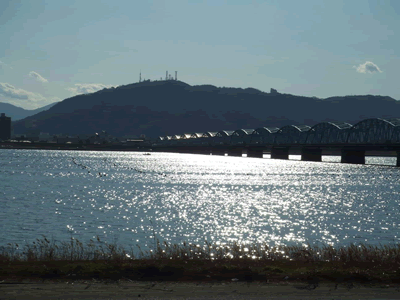| 1.@Ai-gusa, indigo plant |
|
There are a lot of indigo plants' varieties, and these have been used as materials of blue colored dye in all
over the world since ancient times. In Japan, some kinds of indigo plants such as Ryukyu indigo, originally coming from Assam area in India passing through Un-Nan area in China, or Tade (water pepper) Ai, coming from South-East Asia also via China are used. Because of gaining the blue pigments and preserving well, these indigo plants are fermented and processed to Sukumo or indigo lee and then they are used to dye. |
| 2.@History of Awa Ai |
|
The origin of Awa Ai is still uncertain. According to one account, Lord Iemasa Hachisuka introduced indigo to Awa no Kuni (Tokushima) in 1585, but other evidence suggests that indigo was already an important source of revenue in the Muromachi Period (1378-1573 AD). By the Edo Period (1603-1867 AD), Awa Ai was extremely profitable under the protection and control of fiefs (Han). The market share of Ai was almost monopolized by Awa Ai in Japan, and economics, society, and culture in Awa were influenced a lot because of the effects of production increase and prosperity. After the year of 1903 (36th year of the Meiji Period, the peak year of Awa Ai sales), the amount of production had been reducing because of Indian indigo which is cheaper than Awa Ai and chemical one which can be produced a lot. In recent years, interests for nature-oriented and value-oriented products have gradually increased and Awa Ai has been evaluated again as natural goods based on the recognition for it. |
| 3.@Growing the Indigo Plant |
|
In late winter, the indigo plant seeds are planted in the fields. In April the small plants are transplanted. In July, the plants are harvested for the first time, followed by a second harvest in August. The harvested leaves are spread out on an open area under the strong summer sun for one day and then mixed after the leaves have been dried and both of the leaves and stems are separated. The remaining leaves are further dried and will later be fermented and used to make "Sukumo" and eventually Awa Ai. |
| 4.@Sukumo, raw indigo dye |
|
After planted, harvested and dried Tade Ai (water pepper indigo of Polygonaceae),
the Sukumo producers called Ai-Shi use their traditional technique for making Sukumo,
which is one of the most important materials for Japanese indigo dye. It is made by placing dried indigo leaves in a fermentation bed and spraying them with water between 15 to 20 times. After 5 to 7 days, this process is repeated. After about 3 months of repeated spraying and fermentation, a solid mass with a dark brown color appears as its final step. |

| 5.@Making the Dye@- dyeing by Ai |
|
The solid indigo dye material will not dissolve in water alone. However, it is neccessary to turn
the solid indigo dye material into a liquid. The process of changing the solid indigo dye material
into a liquid solution is called "making the dye --ai wo tateru." (On this process, there is a way using chemical materials, but Isso uses only natural ones following the traditional way.) First, the solid dye material (Sukumo) and alkali are mixed in a special pot called an "Ai Game." The next day, a nutrient like glucose is added to the mixture. Five days to one week later the surface of the solution becomes a bluish-purple color and the liquid underneath becomes a brown color. At this stage, the solution can be used to dye various materials. The small bubbles which appear on the surface are called "indigo flowers --Ai no Hana." After dipping the cloth in the dye, it firstly turns brown. Next, the cloth becomes an indigo blue color, but has green hues. Finally, the cloth is washed in water and becomes a splended blue color. The beauty and variety of Awa Ai comes from the length of time the fabric is submerged in the dye and the skillful hand of the person dying the fabric. |
|
Referance: "Ai. Indigo" written by Tokushima Aizome Research |











